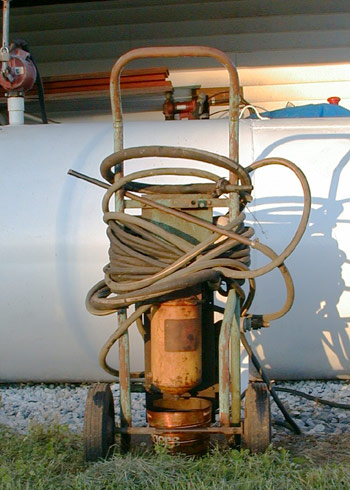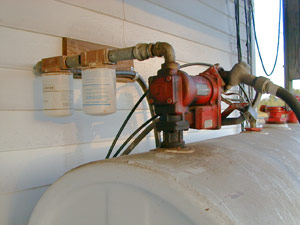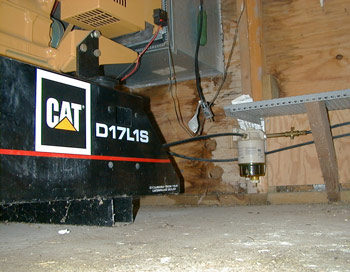
*Fuel Polisher for Diesel Storage*
For those of us who perhaps own a diesel powered truck, car or generator, having a supply of stored diesel fuel on hand is like money in the bank. On our farm, we have a capacity of 1,000 gallons in 3 large, above ground tanks and those are further augmented by a number of 55 gallon steel drums. We refill the tanks when diesel or #2 heating oil is cheap (it’s essentially the same product, save that #2 heating is dyed red for road tax purposes). In the winter, both fuels are more expensive due to the demand for heating fuel. The price tends to drop off during the early summer and I refill typically during late May or early June.
Unlike Gasoline, when stored properly in sealed tanks or barrels and treated regularly with a biostat, Diesel and heating oil typically have a storage life of about 8 years.
So, one day the power goes out, you fire up the diesel generator, put it on line and life is good again. After 3 hours running time, the engine starts to miss, white smoke starts belching from the exhaust and your reliable diesel engine comes to a stop. What happened? 99% of the time, the only problem that will shut a diesel down is a lack of air or fuel for combustion. You check the air filter and it’s clean. Remove the fuel filter and a quick look at the element reveals the problem. It’s clogged with a dark material that has the consistency of coarse sand. No problem, put on the spare (we all have spare maintenance parts, right?) Prime the fuel pump, hit the starter and it’s off an running again… for another 3 hours when the same thing happens.
You just learned the hard way that maintaining your fuel system is cheaper and easier than fixing it. What happened?
While both diesel and #2 fuel oil store well and are far less dangerous to keep on hand in quantity, there is a drawback. Both will support the growth of algae in the fuel. As the algae dies off, it stays suspended in the fuel until it settles to the bottom of the tank as sludge. Even if the fuel pickup tube is raised above the bottom of the tank, the algae in the fuel and sludge in the tank will eventually clog your engines fuel filter.
There are ways to mitigate this problem. First, put your fuel in clean tanks or barrels. Second, plan a regular treatment of your fuel with a biostat. I suggest using marine biostat as it is designed to treat diesel which typically sits in the fuel tank of a boat much longer than gasoline. Boats which use diesel have greater fuel capacity and don’t use fuel nearly as quickly as one that is gasoline powered. When choosing a biostat, note the active ingredient. The next time the fuel is treated, choose a biostat with a different active ingredient. Treat the fuel once in the spring and once in the fall. Third, “scrub” your fuel with a fuel polisher.
A fuel polisher is nothing more than an electric pump capable of pumping fuels, a large fuel filter which traps contaminants 10 microns or larger (your engine filter typically traps particles 3 microns or larger), a pickup hose with a piece of ½” copper tubing fitted to one end and a discharge hose. The copper tubing on the intake line has a 45 degree angle cut on the end which can be inserted in the tank so it can reach the the bottom into the tank but not become blocked if happens to sit square against it.
Our fuel polisher is home made and shown sitting beside one of our storage tanks:

I used a positive displacement pump powered by an electric motor, the filter came from a large Clark forklift and has a changeable 10 micron element. The filter was sized based on the flow rate of the pump. This pump is one I located used and is rated at 10 GPM. I matched it with a filter element capable of 15 GPM. Avoid matching a 10 GPM pump and a 5 GPM filter. All the plumbing between the filter and pump is done with steel pipe whose threads are sealed with fuel grade (usually yellow) Teflon plumbing thread tape. The filter element and housing can be purchased from any gasoline station jobber. A 10 micron filter seems to be a good compromise between adequate flow and trapping the most contaminants.
The hoses and A/C cord are long enough so that the polisher can be operated AWAY from the fuel storage tanks. For added safety when using the polisher, I always keep a class BC fire extinguisher on hand, remain in attendance, turn the rig so I can easily get to the kill switch on the pump> Finally, plug the A/C line into an outlet that is not near the operation so you can get to if should there be an accident.
My tanks are slightly elevated on one end so the sludge will tend to settle in one end with the low spot being under the filler cap. This enables the intake of the polisher to be located in the low spot in order to pull out any sludge which might have settled there and trap it in the filter element.
For drums, simply place a brick or 2 X 4 under the bottom, directly opposite one of the bungs to accomplish the same thing.
So, how’s it work? First of all NOT on Gasoline!
To clean up diesel fuel, the process is simple and effective. Insert the fuel pickup hose from the polisher in the fill opening of the tank locating the end of the pickup tube on or very near the bottom. Insert the discharge into a vent pipe or other opening. In the case of a 55 Gallon drum, open both the vent and discharge bung and insert the pickup and discharge hoses, one into each.
Once the hoses are in place, make sure the discharge hose is secure, then turn on the pump. I might run the polisher on each of the 500 gallon tanks, like the one in the picture above, 2-4 hours. A 55 gallon drum, maybe 30 minutes or so. The idea is to pass the fuel stored in the tank through the filter several times and remove as much of the algae and sludge as possible. In my situation, one $18 filter is good for 2 polishing sessions before a new element is installed.
I use the polisher during my regular fuel treatment intervals. The last 10 minutes of polishing is a good time to add biostat to the stored fuel. Pour it in through same hole the discharge line is located. This technique evenly distributes the biostat throughout the fuel in the tank.
To provide another level of protection for the tractor and vehicles, I have added 2 spin-on filters on the line going to the dispenser nozzle (pictured below). One is a water separator and the second, a particulate filter. The filters and spin-on mounts were purchased for less than $20 at Agri-Supply, a local farm supply store. Again, steel pipe and fuel proof Teflon plumbing tape to seal the threads was used.


Maintain a regular treatment program, keep the fuel and tank clean and protect your diesel powered goodies with an extra fuel filter on each. It’s far cheaper and more convenient to be proactive than gunk up an engine fuel filter or even worse, have to rebuild a fuel or injector pump, set of injectors or even all 3.
COMMO
www.alpharubicon.com
All materials at this site not otherwise credited are Copyright © 1996 - 2007 Trip Williams. All rights reserved. May be reproduced for personal use only. Use of any material contained herein is subject to stated terms or written permission.